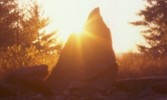

An Analysis of “V” Indentation Features
at America’s Stonehenge
By Mary E. Gage
May 30, 2021
Introduction
At the America’s Stonehenge site in Salem, New Hampshire researchers and visitors are generally familiar with two V shape indentations. One is a V shape cutout in a stone slab of the Abandoned Chamber (a/k/a “chamber in ruins”) and the other is a V shape cutout in a stone slab in the East-West Chamber. The long standing hypothesis which is reiterated in the official site tour guide is the V cutouts were “levering points” for moving the stone slabs. A careful investigation of the site found five other stone chambers had V indentation features integrated into them. Although these features were constructed differently from the V shape cutouts, they all shared one key common characteristic: V shape.
Were these V indentations intentionally constructed features? If so, what purpose did they serve? Does the levering point idea holdup? Or was there another reason for these features? This article explores these questions.
Collapsed Chamber – V Indentation
The Collapsed Chamber consists of a double unit: a chamber with a collapsed roof on the east side with an attached enclosure (now backfilled with earth from various excavations) on the west side. At the base of south wall of the unit is a V indentation. It measures 1’ 9” high by 2’ wide x 1’ 6” deep. It is made up of two large equally sized boulders with flat sides set in a V shaped position. That is their interior ends abut and their exterior ends angle outwards away from each other creating a V shape. On top of the V shape opening is a thin slab, a lintel stone.
Is it an intentional feature? The lintel stone strongly suggests it was purposefully designed as a V indentation. If another example of a V indentation with a lintel stone was found, it would demonstrate a repeated pattern and thus confirm its intentionally beyond any potential doubt. Is there another example on site?
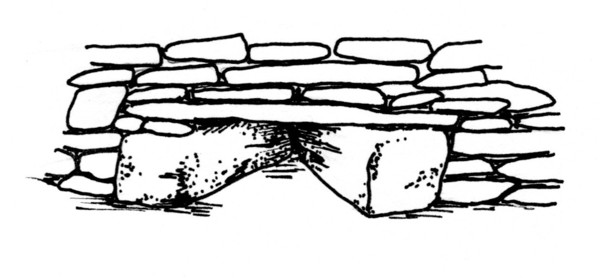 |
Figure 1 – V indentation with lintel stone in Collapsed Chamber Unit wall
Mensal Stone Chamber — V Indentation
This chamber has a large stone slab that was pried loose from the bedrock and lifted up in place. To hold it in a tilted up position, boulders were placed under its sides thereby keeping the middle open space. Next to the chamber and embedded into the interior of the wall is another V indentation with a lintel stone. It is the same as the indentation in the Collapsed Chamber. It too is at the base of the wall. The feature is in situ (i.e. it is original not restored) thus showing these chambers can be scientifically studied.
The lintel stone covering both V indentations proves they are intentional features. The use of the same feature at the base establishes a pattern. The pattern is a V shape indented into a chamber wall its base.
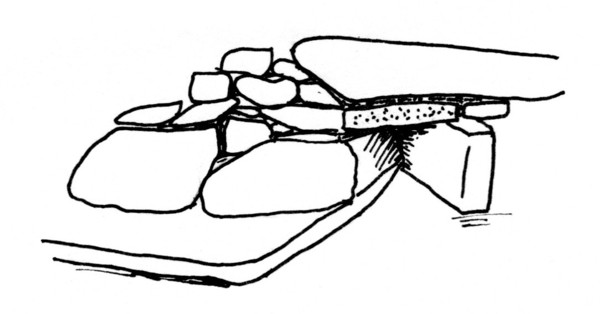 |
Figure 2 – V indentation with lintel stone in Mensal Stone Chamber wall
Abandoned Chamber — V Indentation
The stone slab (6' 6" H x 11' 6" L x 1' Thick) forms a side wall of a chamber that was never completed. It leans against the end of a sturdy stone wall. At the bottom of the slab there is a V shaped cutout that goes part ways through the slab. It is upside down at the base of the slab. Directly across from the cutout and facing it is a boxed in niche. The niche is on the backside of a rectangular slab (4' 2" H x 4' 2" W x 1' 1" Thick). Pattee used the opposite side for the back of his fireplace/chimney. Bricks were found in a pile in front of the short slab. The niche and stone wall combined with the upright stone slab show the structure was the beginning of a chamber abandoned in an unfinished state.
The cutout has been speculated to be for moving the slab. This takes a little more exploring. To find out if this was an accurate statement I looked at other large stone slabs. The 5' 6" W x 5' L x 1' Thick slab used for the roof of the Sundeck Chamber does not have a notched cutout. The 6' 3" W x 8' L x 10" Thick Grooved Stone does not have a notched cutout. The roof slab 16' L x 6' W (approximate) spanning half of the Collapsed Chamber's roof does not have a notched cutout. These slabs are equal or greater in overall size to the slab with a V cutout. Why is it they do not have a cutout for moving them? Here a reverse pattern occurs. The majority of the large stone slabs on the site lack a small cutout thus debunking the idea the feature was used for moving purposes.
The upside down partial V cutout is at the base of the chamber wall. This is the same pattern as found in the Collapsed Chamber and Mensal Stone Chamber albeit these two chambers had a radically different type of V shape indentation. Nonetheless all three chambers have a V shaped indentation at the base of wall.
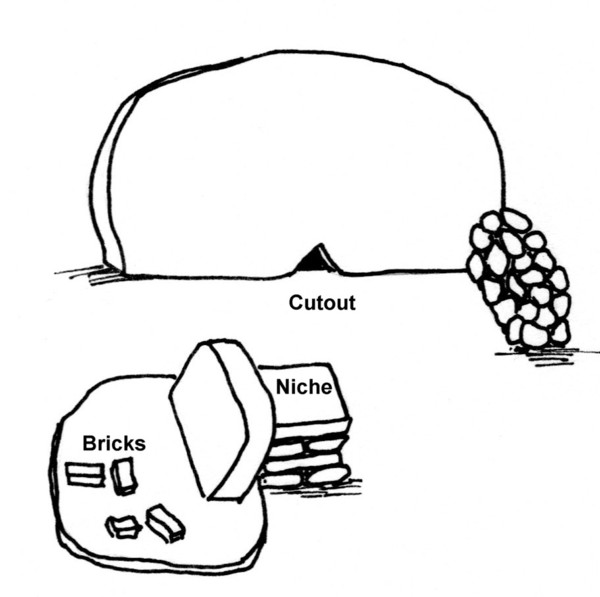 |
Figure 3 – Cutout at base of Abandoned Chamber slab wall
East-West Chamber - V Indentation
The exterior side wall at the entrance to the East-West Chamber is a slab with an upside down V cutout. The cutout goes from the exterior to interior completely through the wall. The side wall’s thick slab is original. There is a 1920's photo showing it in situ. The cutout appears to be a natural feature that was utilized by the builders. Note the opposing slab on the opposite side of the entrance does not have a cutout. The two slabs are nearly the same size. That raises the question why does one have a V cutout and the other does not?
The single V cutout is consistent with the other chambers also having a single V indentation. The V is at the base of the wall which matches the placement in the other chambers. What is different is it goes completely through the wall. That has not been seen yet. Another factor is a slab makes up the wall versus multi-stone construction as in the Collapsed Chamber and Mensal Stone Chamber walls. The slab used as a wall stone matches the slab wall in the Abandoned Chamber which had a partial V cutout. That introduces a new pattern slab wall construction. At the America's Stonehenge site the chambers are interconnected in one way or another. That is each chamber has a feature or trait that shows up in other chambers. It has already been proven the V cutout was not used for moving. Its purpose is the same as the other V features. What is it?
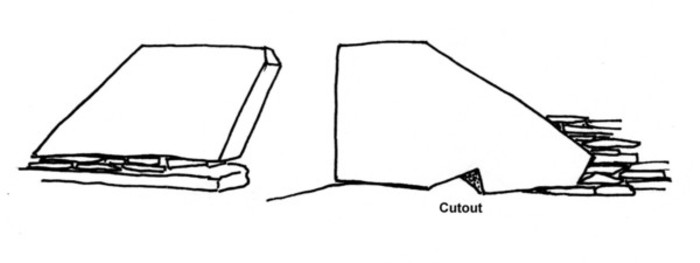 |
Figure 4 – Cutout at base of East-West Chamber slab wall
(roof stones and remainder of exterior walls not shown)
Oracle Chamber – V Indentations
Upon entering the Oracle Chamber a tiny secret room is encountered off of the large north-south room. The tiny room has a large stone slab wall with an opening under it. The slab's bottom is wide on one end slanting upwards becoming slightly narrower near the entry. A support stone was needed to keep the slab up on the narrow end. However, the open space underneath was not completely filled in with support stones. A single block of stone was used on the end leaving a semi-rectangular opening from the exterior to the interior. Exactly like the V shaped opening in the East-West Chamber. The semi-rectangular opening again is at the base of the wall. The pattern holds up albeit with a different shape in this case.
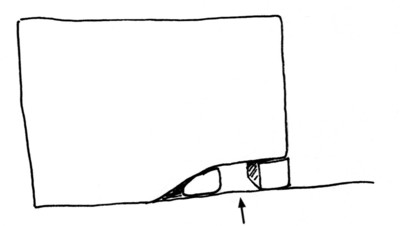 |
Fig 5 – Opening between North-South Room and the tiny room in Oracle Chamber
At the extreme end of the east wing there is a V shaped indentation at floor level next to the drain deep inside. It is integrated into the floor plan. This type of V indentation was also found in the Watch House Chamber (see below) so two examples exist on site.
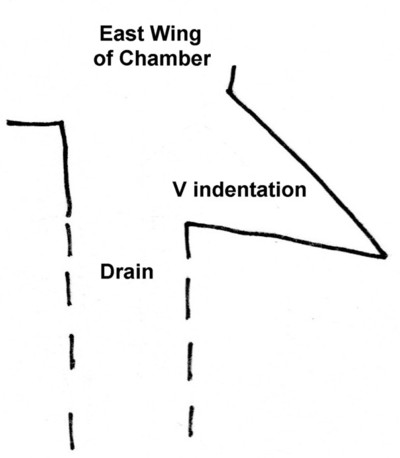
Figure 6 – Floor plan near the drain in the “East Wing” of the Oracle Chamber
The stone slab with the petroglyph in the east wing is a lintel stone above an exposed recessed boulder. The feature creates a recessed open space within the wall. The open space is adjacent to a niche. The niche has two openings one fronting into the chamber. The second opening (place your hand inside and feel around to the left) has an upside down V shape and is between the niche and the recessed boulder. This proves the recessed boulder is an intentional feature. It too showed up in another chamber (see South Facing Chamber below).
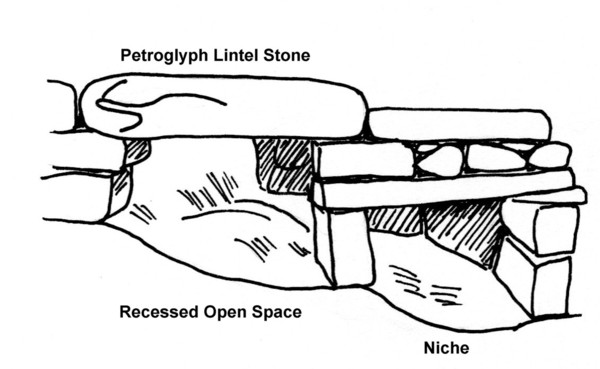 |
Figure 7 – Niche, recessed open space, and lintel stone with petroglyph in “East Wing” of Oracle Chamber
South Facing Chamber — V Indentation
The South Facing Chamber has an exposed recessed boulder in its interior wall. It is interesting in that here the V shape was integrated into it. The bedrock has a thin white line and a thick white line. The lines are wide apart at the front angling inward like a V towards the back. To compensate for the thick white line the wall was built so that only a narrow portion of the white showed thus creating two narrow white lines appearing to form a V shape. Above the opening is a white lintel stone. The feature in is the far back corner at floor level deep inside the chamber like what was seen in the Oracle Chamber.
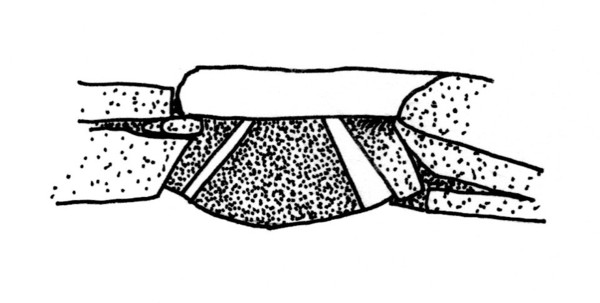
Figure 8 – Angled white lines in rock in upside down “V” shape inside South Facing Chamber
Watch House Chamber — V Indentation
The Watch House Chamber has a V shaped opening going deep into its dark back corner. It was dug out of the earth and walled up on one side. It was integrated into the floor plan. Above the entry into the V feature is a key stone with two black bands and a wide rust band in the middle. It took the place of a lintel stone. This makes the three lintel stones that contain symbolism: white lintel stone, lintel stone with petroglyph and lintel stone with colored bands.
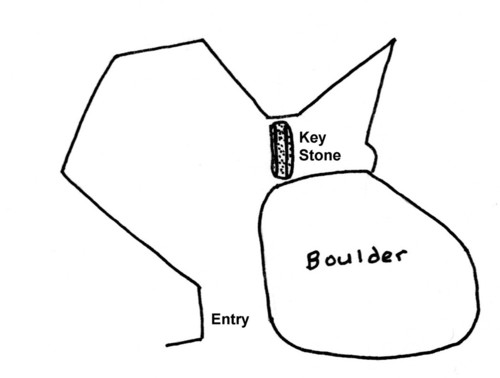
Figure 9 – Floor plan of Watch House Chamber shows V shaped opening with key stone with symbolism above it.
V Hut Chamber — V Indentation
The V Hut Chamber was apply named because its interior walls are in the shape of a V. There are three roof stones with progressive appropriate sizes from large to small. It is a simple, plain chamber containing the V shape within its overall design.
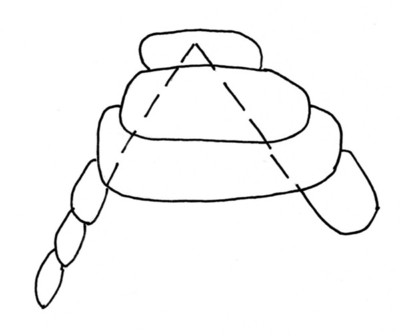 |
Figure 10 – V Hut is laid out as a “V” shape
Small Cave –V Indentation & Long Tall Wall
At the cliff on the west side of the site, is a narrow natural opening leading down to the upper level of the cliff and a small cave. The face of the cliff forms a long, tall wall with the cave underneath on its extreme end. Inside the cave the back corner forms a natural V shape. How do we know this cave has any connection with the chambers on the hilltop?
Down slope a few feet in front of the cave there is a man-made niche. The niche proves the cave was once part of the ceremonial site. Thus it can be used in the research of the site.
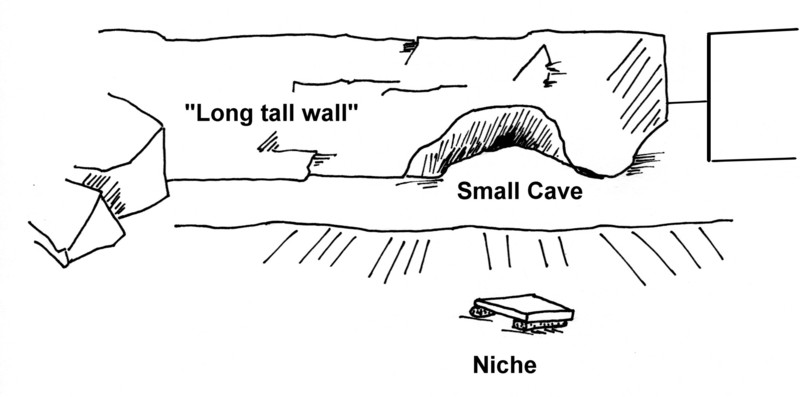 |
Figure 11 – Small Cave
Tall Phase of Chamber Construction
Back up on top of the hill. Several different architectural styles were used in building the chambers. One was the Tall Wall Era. In the Tall Wall era long, tall walls were erected with chambers on their extreme far ends. This mimics the layout of the small cave thus solving a long standing mystery of the where the idea for the Tall Wall chambers originated.
The Tall Wall was one of six distinct architectural styles: Low Wall, Tall Wall, Crawl-in [Height], Walk-in [Height], Open Front and Slab Wall. The architectural styles are listed in the order of their history at the site from oldest to youngest. Each new style replaced the previous style. Overall, the different styles represent a 3,000 year plus period of time. [Please see book The Architecture of America’s Stonehenge (2021) for in depth discussion.]
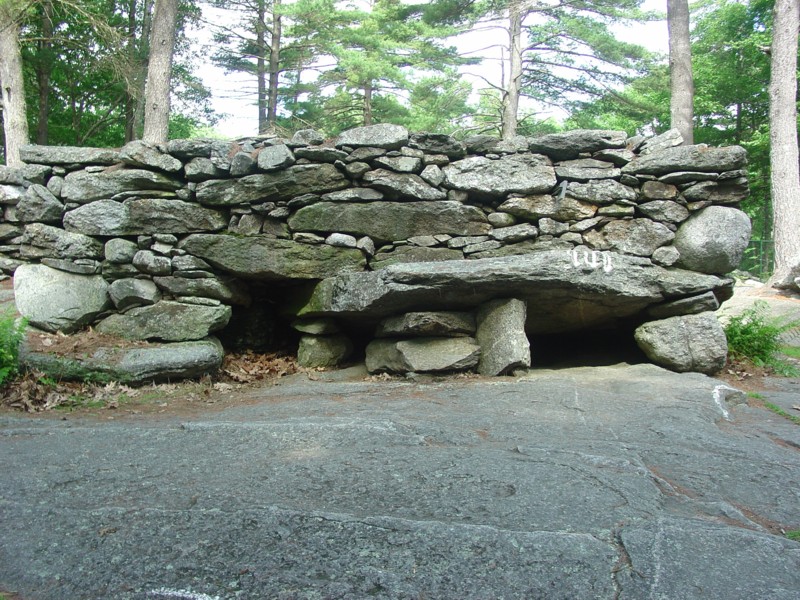 |
Figure 12 – The Mensal Stone Chamber is an example of the Tall Wall architectural style
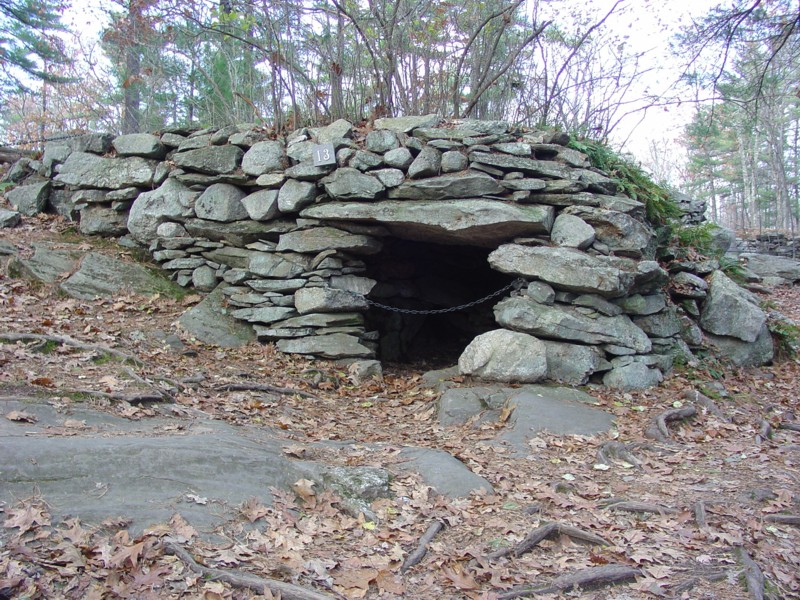 |
Figure 13 – The South Facing Chamber is an example of the Crawl-In [height] architectural style
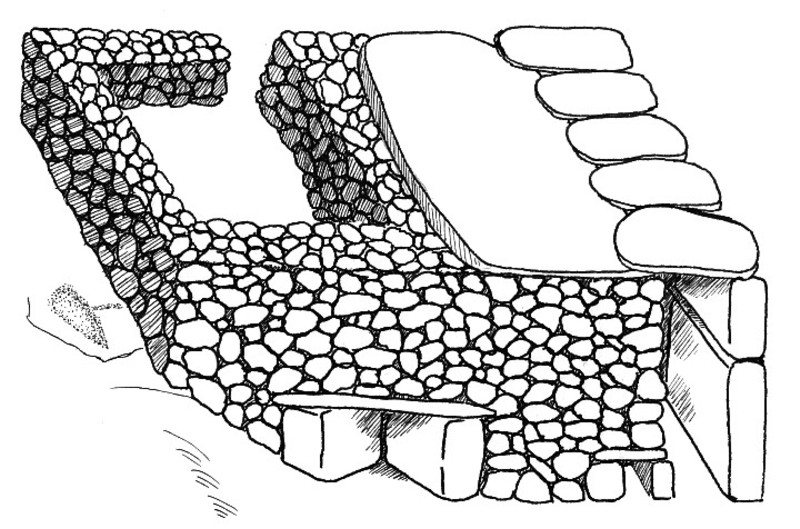 |
Figure 14 – Author’s reconstruction of the Collapsed Chamber Unit. This chamber is an example of the Walk-In [height] architectural style
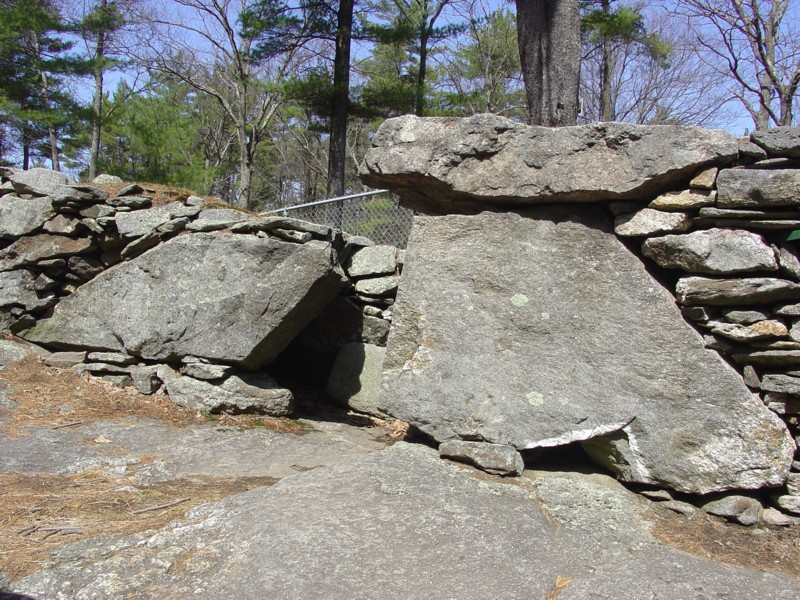
Figure 15 – The East-West Chamber is an example of the Slab Wall architectural style
Discussion
The V indentations showed up in seven chambers and one utilized natural feature. They came in different styles: V indentation in a wall, V cutout in a wall slab, exposed recessed boulder and V indentation in a floor plan. The consistent factor was the V shape. In addition to the shape was the placement. All the features were at the base of the wall and/or floor level. This produced two consistencies. In three of the chambers it had lintel stones with symbolism. In one chamber it opened into a niche. These factors indicate it was used for ceremonial purposes.
Conclusion
The V indentations were one of several architectural characteristics found incorporated into the stone chambers that were recreations of natural characteristics found in the small cave. Although the V indentations came a variety of different forms, they consistently maintained their low position at the base of the chamber. This mirrors the placement of the V indentation at the small cave.
The V indentations found in the seven chambers served no utilitarian purpose. The symbolism noted in the three lintel stones points to a ceremonial purpose. The careful recreation and incorporation of this concept from the small cave implies these indentations were spiritually and cultural meaningful to their builders. These indentations show up in different architectural eras throughout the site’s 3,000 year plus history. The idea and ritual meaning being these V indentations had to have been passed down from one generation to another. Thus indicating the site was the work of a single culture living in the region during this entire time period. The only culture that meets that criteria are the Native Americans.
